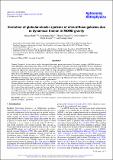Files in this item
Evolution of globular-cluster systems of ultra-diffuse galaxies due to dynamical friction in MOND gravity
Item metadata
| dc.contributor.author | Bílek, Michal | |
| dc.contributor.author | Zhao, Hongsheng | |
| dc.contributor.author | Famaey, Benoit | |
| dc.contributor.author | Müller, Oliver | |
| dc.contributor.author | Kroupa, Pavel | |
| dc.contributor.author | Ibata, Rodrigo | |
| dc.date.accessioned | 2021-10-04T15:30:18Z | |
| dc.date.available | 2021-10-04T15:30:18Z | |
| dc.date.issued | 2021-09-29 | |
| dc.identifier | 276153752 | |
| dc.identifier | 53129565-532c-42d1-b89c-2acfd73103ff | |
| dc.identifier | 85116432195 | |
| dc.identifier | 000701772700005 | |
| dc.identifier.citation | Bílek , M , Zhao , H , Famaey , B , Müller , O , Kroupa , P & Ibata , R 2021 , ' Evolution of globular-cluster systems of ultra-diffuse galaxies due to dynamical friction in MOND gravity ' , Astronomy & Astrophysics , vol. 653 , A170 . https://doi.org/10.1051/0004-6361/202140700 | en |
| dc.identifier.issn | 0004-6361 | |
| dc.identifier.other | ArXiv: http://arxiv.org/abs/2107.05667v1 | |
| dc.identifier.uri | https://hdl.handle.net/10023/24085 | |
| dc.description | Funding: MB and HSZ are thankful for the financial support by Cercle Gutenberg. MB acknowledges the support from the Polish National Science Centre under the grant 2017/26/D/ST9/00449. BF and RI acknowledge financial support from the European Research Council (ERC) under the European Unions Horizon 2020 research and innovation programme (grant agreement No. 834148). O.M. is grateful to the Swiss National Science Foundation for financial support. | en |
| dc.description.abstract | Context. Dynamical friction can be used to distinguish Newtonian gravity and modified Newtonian dynamics (MOND) because it works differently in these frameworks. This concept, however, has yet to be explored very much with MOND. Previous simulations showed weaker dynamical friction during major mergers for MOND than for Newtonian gravity with dark matter. Analytic arguments suggest the opposite for minor mergers. In this work, we verify the analytic predictions for MOND by high-resolution N-body simulations of globular clusters (GCs) moving in isolated ultra-diffuse galaxies (UDGs). Aims. We test the MOND analog of the Chandrasekhar formula for the dynamical friction proposed by Sánchez-Salcedo on a single GC. We also explore whether MOND allows GC systems of isolated UDGs to survive without sinking into nuclear star clusters. Methods. The simulations are run using the adaptive-mesh-refinement code Phantom of Ramses. The mass resolution is 20 M⊙ and the spatial resolution 50 pc. The GCs are modeled as point masses. Results. Simulations including a single GC reveal that, as long as the apocenter of the GC is over about 0.5 effective radii, the Sánchez-Salcedo formula works excellently, with an effective Coulomb logarithm increasing with orbital circularity. Once the GC reaches the central kiloparsec, its sinking virtually stops, likely because of the core stalling mechanism. In simulations with multiple GCs, many of them sink toward the center, but the core stalling effect seems to prevent them from forming a nuclear star cluster. The GC system ends up with a lower velocity dispersion than the stars of the galaxy. By scaling the simulations, we extend these results to most UDG parameters, as long as these UDGs are not external-field dominated. We verify analytically that approximating the GCs by point masses has little effect if the GCs have the usual properties, but for massive GCs such as those observed in the NGC 1052-DF2 galaxy, further simulations with resolved GCs are desirable. | |
| dc.format.extent | 17 | |
| dc.format.extent | 1127138 | |
| dc.language.iso | eng | |
| dc.relation.ispartof | Astronomy & Astrophysics | en |
| dc.subject | Galaxies: structure | en |
| dc.subject | Galaxies: star clusters: general | en |
| dc.subject | Galaxies: kinematics and dynamics | en |
| dc.subject | Galaxies: dwarf | en |
| dc.subject | Galaxies: evolution | en |
| dc.subject | Gravitation | en |
| dc.subject | QB Astronomy | en |
| dc.subject | QC Physics | en |
| dc.subject | Space and Planetary Science | en |
| dc.subject | Astronomy and Astrophysics | en |
| dc.subject | 3rd-DAS | en |
| dc.subject | MCC | en |
| dc.subject.lcc | QB | en |
| dc.subject.lcc | QC | en |
| dc.title | Evolution of globular-cluster systems of ultra-diffuse galaxies due to dynamical friction in MOND gravity | en |
| dc.type | Journal article | en |
| dc.contributor.institution | University of St Andrews. School of Physics and Astronomy | en |
| dc.identifier.doi | https://doi.org/10.1051/0004-6361/202140700 | |
| dc.description.status | Peer reviewed | en |
| dc.identifier.url | http://arxiv.org/abs/2107.05667 | en |
This item appears in the following Collection(s)
Items in the St Andrews Research Repository are protected by copyright, with all rights reserved, unless otherwise indicated.

